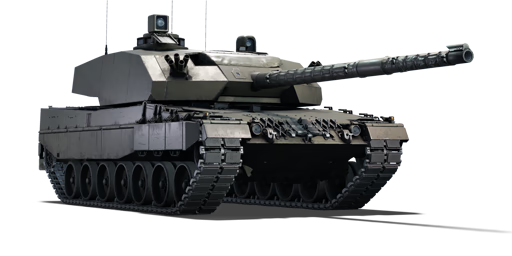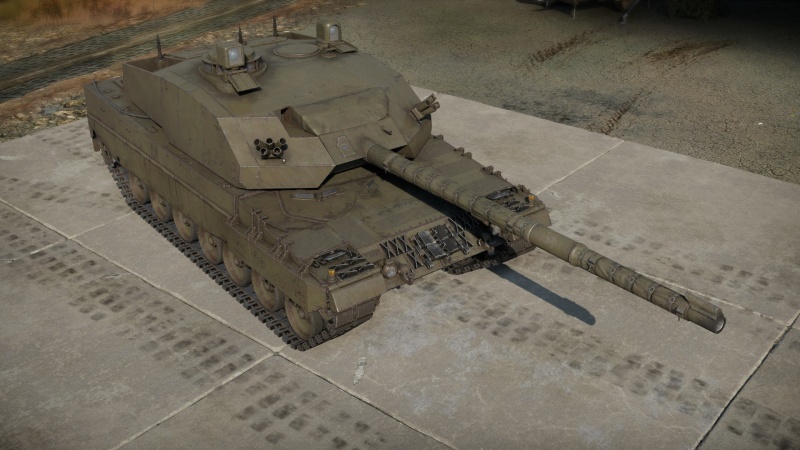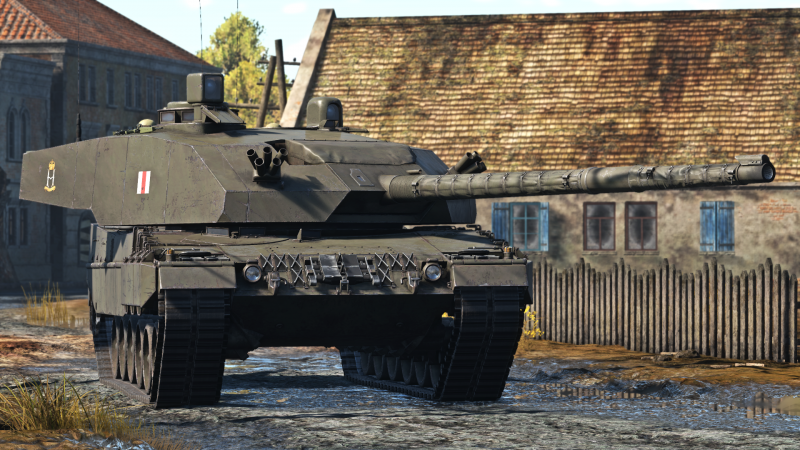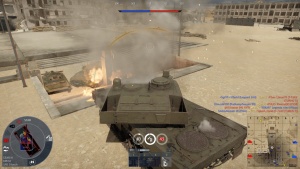Vickers Mk.7
| This page is about the British medium tank Vickers Mk.7. For other versions, see Vickers MBT (Family). |
Contents
Description
The Vickers Mk.7 is a rank VII British medium tank with a battle rating of 10.3 (AB/RB/SB). It was introduced in Update 1.93 "Shark Attack".
The Vickers Mk.7 is a prototype tank design by Vickers during the 1980s. The tank featured a capable fire control system, an effective and tested L11 120 mm gun, similar to those on the Chieftains and as a novelty for the British tech tree, the turret is mounted on the chassis of a Leopard 2.
This very raw input in mobility from the Leopard's engine, matched with the sturdy Chobham armour inside the Vickers turret, grants the veteran tankers of the British tree a fairly unique and dynamic balance of mobility, firepower and armour for a variety of playstyle options.
The tank is not only well balanced in the 3 main categories, but is also armed with improved TOGS, laser rangefinders and various smoke discharging equipment; turning this MBT into a dangerous opponent to meet on the battlefield.
General info
Survivability and armour
The tank has hardened RHA panels behind the front exterior and a lot of composite lists sandwiched between them. Even the gun mantlet has at least 250 mm RHA protection, UFP has at least 300 mm RHA and the turret has anywhere between 350 to 480 mm RHA against kinetic shells. While it isn't perfect, it will often deflect low quality APFSDS.
Protection against chemical ammunition is also very high, although not perfect, turret and UFP being almost always capable to deflect even superior USSR HEAT-FS (only really reliably penetrable at the bottom portion) and completely blocking the rest.
Armour profile is not perfect, so it is possible to fire at the hull roof from a tall tank or high ground (200 mm RHA overall, but no chemical shielding), the turret neck (exposed weakspot with only 6 RHA, vulnerable to any overpressure and autocannons), optics (weird black square on top-left when looking at the tank from the front, 50-90 RHA), or simply fire any heavy chemical shell/ATGM at the very top (windows have poor overpressure shielding and are likely to give in to any amount of damage, at best having 35 RHA). The turret back is also poorly protected, with only 20 mm RHA and side fake panels shielding it, allowing any sufficiently strong HE or autocannon shell to obliterate turret crew. Although the ammo rack is easy to hit, it consists of inert part of the shells (darts), so it won't do much damage, if any, to the crew itself when hit.
What makes Vickers Mk.7 really dangerous, is the ability to abuse high ground to become semi-indestructible. At 60 degrees, and especially at long range (above kilometer), the only places on the turret that are guaranteed to be penetrated by medium quality APFSDS like DM23 are the gun mantlet and the optics. It may even block weak ATGM at this point. Combined with high movement speed of this particular tank make it actually able to take a good position in time, unlike Challenger 1, making it a more worthy successor to the Chieftain 10, even if it's armour profile is less reliable.
| Armour | Front (Slope angle) | Sides | Rear | Roof |
|---|---|---|---|---|
| Hull | 35 mm (53-82°) Upper glacis 40 mm (51°) Lower glacis 30 mm (82°) Driver's hatch |
10 mm + 10 mm (5°) Top - Front 20 mm + 10 mm (5°) Top - Rear 35 mm Bottom - Front 20 mm Bottom - Centre & rear 5 mm Side Skirts 20 mm (39°) Bottom - Belly |
20 mm (12°) Upper plate 20 mm (17°) Centre plate 20 mm (50°) Lower glacis |
30-35 mm (8°) Front 20 mm (0-8°) Centre and rear 5 mm Radiator vents |
| Turret | 20 mm (3-53°) Turret front 30-35 mm (54-75°) Gun mantlet |
20mm (6°) Turret side | 20 mm (0°) Turret rear | 40 mm (0-12°) 20 mm Loader hatch |
| Cupola | 20 mm (cylindrical) | 20+20 mm Outer ring 20 mm Dome | ||
Notes:
- Suspension wheels, tracks and torsion bars are 20 mm thick.
- A 20 mm plate reinforces the hull sides' top area.
- A 8 mm plate separates the crew compartment from the engine compartment.
- Additionally to the outer armour, composite armour is present:
| Composite armour | Front | Sides |
|---|---|---|
| Hull | Front glacis 90 - 350 mm Kinetic 243 - 600 mm Chemical |
N/A |
| Turret | Turret cheeks 350 - 500 mm Kinetic 350 - 650 mm Chemical Gun mantlet (Centre) 250 - 300 mm Kinetic 300 - 600 mm Chemical |
Side armour 150 mm Kinetic 315 mm Chemical |
Mobility
| Game Mode | Max Speed (km/h) | Weight (tons) | Engine power (horsepower) | Power-to-weight ratio (hp/ton) | |||
|---|---|---|---|---|---|---|---|
| Forward | Reverse | Stock | Upgraded | Stock | Upgraded | ||
| Arcade | 81 | 37 | 54.6 | 2,032 | 2,862 | 37.22 | 52.42 |
| Realistic | 73 | 33 | 1,327 | 1,500 | 24.3 | 27.47 | |
By British standards, the tank is extremely fast for how much armour it has. Firstly the tank quickly reaches 40 km/h, then accelerates towards 60 km/h (in AB quickly, in RB somewhat slowly). It can easily drive 60 km/h anywhere afterwards, and if not turned around or going uphill for a while it will accelerate to 80 km/h.
It can also reverse quite quickly with -33 km/h (-36 km/h in AB), acceleration heavily depending on the driver crew skill.
Modifications and economy
Armaments
Main armament
The Mk.7 uses the same 120 mm L11A5 rifled gun as the Challenger Mk.3.
The turret rotation speed is slightly faster, but vertical gun targeting speed is much slower. The base reload speed with first stage ammo rack is a second slower than the Challengers as well. While it isn't fatal, loss of the ready rack advantage may put the tank in a spot where others can fire back at it twice. When fighting over a capture point, immediate ready rack resupply on a cap is necessary to keep up with others.
Shell loadout is identical, early shell works well for mid-Cold War era tanks such as the Type 90, Leopard 2A4, T-64B/T-72A/T-80B, etc., but may struggle when fighting more modern vehicles such as the Leopard 2A5, T-80U, Leclerc, etc. To properly fight in an uptier and to be able to penetrate these tanks at least at 500 m range the L26 shell is required.
| 120 mm L11A5 | Turret rotation speed (°/s) | Reloading rate (seconds) | |||||||||||
|---|---|---|---|---|---|---|---|---|---|---|---|---|---|
| Mode | Capacity | Vertical | Horizontal | Stabilizer | Stock | Upgraded | Full | Expert | Aced | Stock | Full | Expert | Aced |
| Arcade | 50 | -10°/+20° | ±180° | Two-plane | 34.3 | 47.4 | 57.6 | 63.7 | 67.8 | 7.80 | 6.90 | 6.36 | 6.00 |
| Realistic | 21.4 | 25.2 | 30.6 | 33.8 | 36.0 | ||||||||
Ammunition
| Penetration statistics | |||||||
|---|---|---|---|---|---|---|---|
| Ammunition | Type of warhead |
Penetration @ 0° Angle of Attack (mm) | |||||
| 10 m | 100 m | 500 m | 1,000 m | 1,500 m | 2,000 m | ||
| Shot L23A1 | APFSDS | 396 | 394 | 387 | 376 | 367 | 357 |
| Shell L31A7 | HESH | 152 | 152 | 152 | 152 | 152 | 152 |
| L26 | APFSDS | 471 | 469 | 464 | 458 | 450 | 444 |
| Shell details | ||||||||||||
|---|---|---|---|---|---|---|---|---|---|---|---|---|
| Ammunition | Type of warhead |
Velocity (m/s) |
Projectile mass (kg) |
Fuse delay (m) |
Fuse sensitivity (mm) |
Explosive mass (TNT equivalent) (kg) |
Ricochet | |||||
| 0% | 50% | 100% | ||||||||||
| Shot L23A1 | APFSDS | 1,535 | 3.89 | - | - | - | 78° | 80° | 81° | |||
| Shell L31A7 | HESH | 670 | 17.34 | 0.1 | 4 | 6.53 | 73° | 77° | 80° | |||
| L26 | APFSDS | 1,550 | 4.3 | - | - | - | 78° | 80° | 81° | |||
| Smoke shell characteristics | ||||||
|---|---|---|---|---|---|---|
| Ammunition | Velocity (m/s) |
Projectile mass (kg) |
Screen radius (m) |
Screen deploy time (s) |
Screen hold time (s) |
Explosive mass (TNT equivalent) (g) |
| L34 | 670 | 17.1 | 20 | 5 | 25 | 50 |
Ammo racks
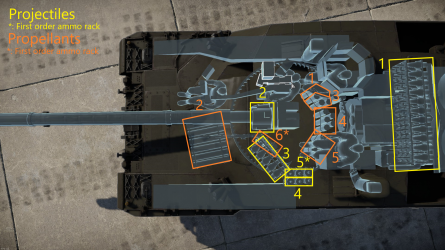
| Full ammo |
Ammo type |
1st rack empty |
2nd rack empty |
3rd rack empty |
4th rack empty |
5th rack empty |
6th rack empty |
Visual discrepancy |
|---|---|---|---|---|---|---|---|---|
| 50 | Projectiles Propellants |
18 (+32) 48 (+2) |
12 (+38) 18 (+32) |
7 (+43) 15 (+35) |
4 (+46) 10 (+40) |
1 (+49) 4 (+46) |
N/A 1 (+49) |
No |
Notes:
- In the case of projectile racks 4 and 5: the rack is shared but the outer half of the ammunition is used as the ready rack and the inner half is stored ammo and thus considered as rack 4 for the purposes of determining load order.
Machine guns
| 7.62 mm L8A2 | ||||
|---|---|---|---|---|
| Mount | Capacity (Belt) | Fire rate | Vertical | Horizontal |
| Coaxial | 2,000 (200) | 600 | N/A | N/A |
Usage in battles
The Vickers Mk.7 is a main battle tank, and thus a tank that should be on the frontlines being the first line of attack. It is considered one of the best armoured MBTs at its battle rating. This is due to its composition; a Leopard 2A4 hull which offers protection against all CE threats except 9M133 Kornet and is able to stop APFSDS rounds with <400 mm penetration, and a custom British turret similar to the Challenger 2 which offers protection against all CE threats except 9M133 Kornet and APFSDS rounds with <405 mm penetration. Thanks to this, the Vickers Mk.7 can be used in a variety of engagements at both short and long ranges with high chances of survivability.
In urban combat:
Close quarters combat is one of the most risky engagements in the game, but thanks to the superb armour of the Vickers Mk.7, it is able to have multiple engagement modes when in CQC.
Battering Ram:
Vickers Mk.7 can be used as the tank who will push through the enemy line due to its armour. Be aware of how the chassis is poked between corners as the hull is only armoured in the frontal plate. Any shot fired at the track's sprocket can be fatal as there is no armour to stop the incoming shell. When fighting in an uptier, avoid being the battering ram as all 10.3-10.7 vehicles can punch through any part of the frontal armour (including turret) and destroy the tank in a couple of shots. Be aware of facing enemy tanks like the Leopard 2A6 and Leclerc S2 which have extremely powerful APFSDS rounds that will go through the Vickers Mk.7's armour like hot knife through butter. When in a downtier, you are able to be the battering ram as only a couple vehicles at the battle rating will be able to pierce through your armour (tanks like the Type 16, T-62M-1 and Type 74 will be able to punch through your armour between 8.7 and 9.7, be aware as they penetrate between 405 mm and 450 mm of armour with APFSDS). Try to stick with people behind you so friendlies can assist you if needed, sometimes who can pull you with a winch could save both's life.
Bastion defence:
Due to the high survivability, the Vickers Mk.7 is able to hold defensive positions (cap points, strategic locations, etc) quite well, as well as repelling and counter-attacking any aggressor with ease. Due to its powerful engine and transmission, it is able to move forward, fire, and move backwards in quick succession.
*Note: the Vickers Mk.7 most prominent weak spot in the turret is the mantlet, always be on the lookout to hide it as much as possible or by wobbling your turret a little so enemies have a smaller chance to hit the mantlet.
In rural combat:
Due to the longer ranges compared to the urban combat, the Vickers Mk.7 is able to use multiple techniques and combat roles to fulfil the player's preference.
Sniper:
Thanks to the high velocity stock ammunition, the Vickers Mk.7 is able play as a sniper in long range maps. This, with the addition of the laser rangefinder and thermal imaging sights, makes the Vickers Mk.7 a fearful sniper as only certain tanks will be able to pierce your turret past 500 m. Be aware and despite having a strong hull always try to get in hulldown position in order to hide the frontal weakspots of your tank (lower frontal plate, turret ring). At longer ranges, enemies will take even more time in order to hit and damage the Vickers Mk.7 when it is hulldown.
You can always push your advantage by looking for any kind of high ground, be it a hill, an enormous dune that towers over the map, or any other. This will make Vickers 7 nearly impenetrable at its own BR and below, allowing you to take time to actually aim. Remember to move away after firing - although the turret armour is very tough, it is only barely able to stop APFSDS of your BR, giving shells with ~230+ mm penetration at 60 degrees to have a random low chance of penetrating the turret anyway. This is particularly important in AB, where enemies can see the yellow crosshair and may decide to "play the lottery" against you for the lack of better options. This tactic gives no real advantage against shells with extreme angled penetration of the Soviet or tanks of the next rank in general.
Flanking:
As much as crazy it sounds, the Vickers Mk.7 has an impressive speed of 75 km/h even with all the armour. Thanks to this, the Vickers Mk.7 is able to move around and push behind enemy lines and retreat or move to wherever is needed. Thanks to the stabilizer, it is able to fire on the move if needed for a quick "Hit 'n' Run" tactic. It has a slow reload rate (7.8 seconds stock) which can cause issues when engaging targets in a fast manner. Use smoke if needed to retreat and relocate.
Pros and cons
Pros:
- Accurate main gun with HESH and smoke as support rounds
- Excellent mobility in all directions, also effective off-road mobility
- Respectable turret armour compared to some tanks at the battle rating; extremely powerful on high ground; fearful when in downtier
- Decent stock APFSDS shell (394 mm at 100 m at 0°)
- Powerful gun optics (4.0x - 12.0x FOV: 18-6), gun depression, TOGS and laser range finder: excellent tank hunting capabilities
- Two-piece ammunition is stored separately; reduced risk of detonation
- Inert ammo rack behind the turret
Cons:
- Large and tall profile; difficult to conceal from tanks, aircraft or helicopters, no ESS to evade guided missiles
- Difficulties when fighting sloped armour at long distances, chiefly Soviet T-72 (Family) or Leopard 2A6
- Even turret armour will not block modern APFSDS of the similar BR (like DM23 or DM33) unless angled, tanks that have shells with over 250 mm penetration at 60° like T-64B with 3BM42 and PTZ89 with DYW1 will penetrate even at long range anyway
- Weak spots in hull and turret: gun mantlet, turret back, driver position and armourless sides and weak LFP inherent from Leopard 2 (Family)
- Poor insulation against overpressure damage, can even be overpressured from behind through the ammo rack on top of "normal" weak spots
History
After quite a few private tank ventures, and the unsatisfactory development of the Vickers Mark 4, also known as Valiant. The Vickers company brought another design aimed to develop a capable MBT. Either as a replacement for the Challenger Mk.1 then currently in service, or as a valuable modern tank for the exportation. With the support of the Krauss-Maffei company, Vickers matched the up-rated turret of the previous Mark 4 Valiant MBT, with an identical Leopard 2A4 chassis. Thus creating in June 1985, what it became known as Vickers MBT Mark 7.
The Leopards' MTU 838 engine capabilities were well known, and the match with the improved Valiant's Mk 4 turret protected by the powerful Chobham Armour, resulted in an acceptable weight of over 54 tons, providing a top speed of 72 km/h. A speed which was unlikely from most British MBTs of the time - Specially from previous MBTs as the already out phased Chieftains.
Vickers' prototype got fitted with the L11 120 mm gun, the same gun as the contemporary Challenger 1. After these modifications, the Mark 7 went under trials in Egypt, September of the same year. In 1986, using some technologies of the defunct MBT-80 project, the Mark 7 received even greater upgrades: 2nd generation thermal sights with increased resolution, improved stabilization systems for the main gun, reduced thermal and electromagnetic signatures and a new telescopic laser sight. Effectively reworking on the IFCS (Improved Fire Control System) for the 120 mm L11A5 cannon. Equally formidable, the Leopard 2 chassis matched perfectly this gunnery refits; turning the Mark 7 in a very steady tank while firing on the move.
Bittersweet experiences on the CAT 87 (Canadian Army Trophy) with the Army's Challengers 1 pitted against Leopards 1 & 2 and M1 Abrams, made some interest on the Vickers Mk.7 project. Therefore, in October 1987, a comparison test on the Lulworth Gunnery Ranges was performed between a Challenger 1 and a Vickers Mark 7. CHIP (Challenger/Chieftain Improvement Programme) was looking for projects and new technologies to integrate into the serving Challengers 1. At the firing range, Challenger 1 hit seven out of the 8 targets in an engagement time of approximately 21.7 seconds. While the Vickers Mark 7 achieved successful hits to all 8 targets in only 12.5 seconds. This is likely due to old Chieftain's cannon and gunnery systems being fitted into the newer Challenger 1, with only slightly major gunnery improvements aside from TOGS - unlike the modernized Vickers Universal turret.
This universal turret also made possible not only the installation of an IFCS but the modification for different gun mounts such as the Royal Ordnance's L7 105 mm gun. The turret was made in this universal configuration since it was hoped this would suit any potential exportation customers needs, or at least, grow in interest for the British Army. While the army did recount experience in the Vickers Mk 7 and the technologies improvement on gunnery and target requisitioning, in the end, they not procured any contract for it. All the technology research and tests made between the Challenger 1 and the Mk.7 instead lead Vickers and the MOD to develop what was to be known as; the Challenger 2.
Without the interest of the British Army, high productions costs, international political situations and the dependency on a German-made hull, the Vickers Mk.7 did not succeed on the exportation market. Any further research was then halted and the project cancelled, with a single prototype built.
While the fate might seem short-lived, the Vickers Mk.7 proved to be an invaluable leap forward in the modernized MBT development. Not only regarding the CR2 but also because in 1986 the Universal Vickers turret was reproduced to be used by Engesa, on the Brazilian EE-T1 Osório Main Battle Tank
Media
- Skins
- Videos
See also
Related development
External links
| Vickers-Armstrongs Limited | |
|---|---|
| Ships | |
| Tribal-class | HMS Eskimo · HMCS Haida |
| Invincible-class | HMS Invincible* |
| Kongō-class | IJN Kongo** |
| Tanks | |
| Light Tanks | VFM5*** · Vickers Mk.11*** |
| Light Tank Mk VI | Light AA Mk I |
| Light Tank Mk VII | Tetrarch I |
| Light Tank Mk VIII | Alecto I |
| Tank, Infantry, Valentine | Valentine I · Valentine IX · Valentine XI · Archer |
| Vickers MBT | Vickers Mk.1 · Vickers Mk.3 · Vickers Mk.7*** |
| Heavy Tanks | Independent**** |
| Export | ▂МК-IX "Valentine" · Vickers Mk.E**** |
| See also | Vickers-Armstrongs Aircraft Limited |
| *Previously Armstrong Whitworth | |
| **Built for Japan | |
| ***Vickers Defence Systems | |
| ****Previously Vickers Limited | |
| Britain medium tanks | |
|---|---|
| Valentine | Valentine I · Valentine IX · Valentine XI |
| Cromwell | Cromwell I · Cromwell V · Cromwell V (RP-3) |
| Cromwell derivatives | Challenger · Avenger · Comet I · Comet I "Iron Duke IV" · Charioteer Mk VII |
| Centurion | Centurion Mk 1 · Centurion Mk.2 · Centurion Mk 3 · Centurion Mk.5 AVRE · Centurion Mk 10 · Centurion Action X · FV4202 |
| Vickers MBT | Vickers Mk.1 · Vickers Mk.3 · Vickers Mk.7 |
| Chieftain | Chieftain Mk 3 · Chieftain Mk 5 · Chieftain Mk 10 |
| Challenger 1 | Challenger Mk.2 · Challenger Mk.3 · Challenger DS |
| Challenger 2 | Challenger 2 · Challenger 2 (2F) · Challenger 2 TES · Challenger 2 OES · Challenger 2E · Challenger 2 Black Night |
| Challenger 3 | Challenger 3 TD |
| Australia | A.C.I · A.C.IV · Centurion Mk.5/1 |
| South Africa | Olifant Mk.1A · Olifant Mk.2 · TTD |
| India | Vijayanta · Bhishma TWMP |
| Israel | ▄Sho't Kal Dalet |
| Jordan | Khalid |
| Sweden | ▄Strv 81 (RB 52) |
| USA | Grant I · Sherman II · Sherman Firefly · Sherman IC "Trzyniec" |


